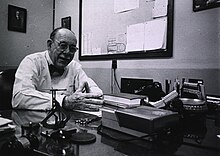Edwin Boring
Edwin Garrigues Boring (born October 23, 1886 in Philadelphia , † July 1, 1968 in Cambridge ) was an American experimental psychologist and one of the first psychology historians.
Life
Boring was born in Philadelphia in 1886 and went to study at Cornell University in Ithaca , New York in 1904 , where he graduated as a Medical Examiner in 1908 . After working as a teacher and attending psychology courses at his university (including with Edward Bradford Titchener ), he returned to the university in 1910, where he obtained his Ph. D.
In 1917, when the USA entered the First World War , he left Cornell University and went to Robert Yerkes , who was entrusted with recruitment tests by the US military. He worked with David Wechsler . In 1919 he got a temporary position as professor of experimental psychology at Clark University in Worcester , Massachusetts . After the future of psychology at Clark University was unclear after its three-year term, Boring took a position as adjunct professor at Harvard University in Cambridge , Massachusetts, where he remained until the end of his life.
He became known beyond the specialist public for his ambiguous pictures, the so-called Boring pictures . In the illustration on the right, two motifs can be recognized. The age varies between 15 and 95 years, depending on the viewer. The background is the figure-ground process, which is based on gestalt perception in gestalt psychology . When a person has learned to recognize both shapes, perception oscillates between the two possible interpretations, but both shapes can never be seen at the same time.
Boring was married to Lucy May Day, who received her PhD from Cornell University two years before him. The two had four children. Boring was elected to the American Academy of Arts and Sciences in 1924, the National Academy of Sciences in 1932, and the American Philosophical Society in 1945 .
Publications
- A History of Experimental Psychology (1929)
- The Physical Dimensions of Consciousness (1933)
- Sensation and Perception in the History of Experimental Psychology (1942)
- Introduction to Psychology (1938)
- Psychology for the Fighting Man (1943)
- Psychology for the Armed Services (1945)
- Foundations of Psychology (1948, with Herbert Langfeld and Harry Weld)
- Psychologist at Large: an Autobiography and Selected Essays (1961)
- History, Psychology, and Science: Selected Papers (1963)
Footnotes
- ↑ The original version of the picture was published by Boring, Edwin G .: A New Ambiguous Figure , in: The American Journal of Psychology , Vol. 42, No. 3 (Jul.), 1930, pp. 444–445, here p. 444. However, the picture originally goes back to the cartoonist WE Hill, who published this picture in Puck magazine (November 6, 1915 issue).
- ^ Member History: Edwin G. Boring. American Philosphical Society, accessed May 12, 2018 .
Web links
- Edwin Boring in the nndb (English)
| personal data | |
|---|---|
| SURNAME | Boring, Edwin |
| ALTERNATIVE NAMES | Boring, Edwin Garrigues |
| BRIEF DESCRIPTION | American experimental psychologist and psychology historian |
| DATE OF BIRTH | October 23, 1886 |
| PLACE OF BIRTH | Philadelphia |
| DATE OF DEATH | July 1, 1968 |
| Place of death | Cambridge |

